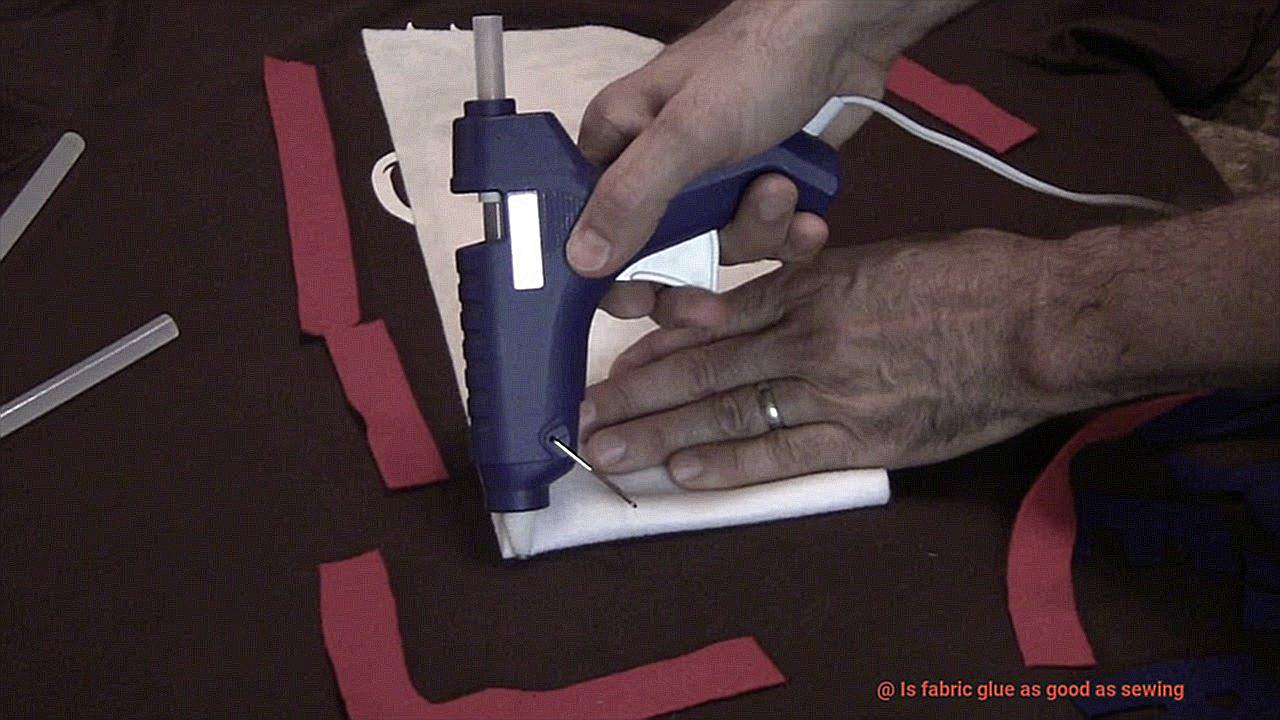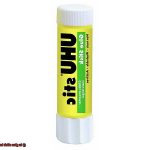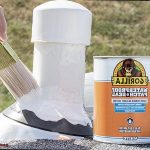The age-old battle between fabric glue and sewing continues to divide the world of garment construction. On one side, there are die-hard sewing enthusiasts who swear by its precision and durability. On the other side, there are those who embrace the simplicity and convenience of fabric glue. But which method truly reigns supreme? In this blog post, we’ll dive deep into the pros and cons of both techniques, taking into account practicality, durability, and the overall aesthetic impact they bring to your creations.
Let’s start with sewing—the tried-and-true approach that has stood strong throughout history. With its intricate detailing and secure hold between fabric layers, sewing is known for producing polished and professional-looking garments. However, it does require specialized equipment, skill, and a significant investment of time. This makes it less suitable for quick fixes or beginners looking for a hassle-free experience.
Now let’s turn our attention to fabric glue—a straightforward alternative that’s as easy to use as spreading butter on toast. It’s readily available and can be a lifesaver for minor repairs or when time is of the essence. Fabric glue also shines when working with non-sewable materials like sequins or plastic embellishments, adding versatility to its repertoire. However, its long-term durability can vary, especially when faced with washing or frequent use. And let’s not forget that achieving the same level of neatness and precision as sewing can be quite challenging with fabric glue.
Both methods have their place in garment construction—each with its own set of advantages and drawbacks that you need to consider carefully before making your choice. Your decision will depend on factors such as the specific project at hand, your skill level, time constraints, and personal preferences. In the following sections, we’ll explore these factors further so that you can make informed decisions regarding your garment projects.
In conclusion, while fabric glue offers convenience and accessibility, sewing remains the go-to method for those who prioritize durability, precision, and a professional finish. By evaluating the practical and aesthetic implications of each technique, we hope to assist you in determining which approach will best suit your garment construction needs.
So, whether you’re a sewing aficionado or a glue enthusiast, get ready to weigh the pros and cons as we embark on this journey to find out if fabric glue can truly match up to the power of sewing. Let’s settle this once and for all.
Advantages of Fabric Glue
Contents
When it comes to joining fabrics together, sewing has long been the go-to method. However, fabric glue offers a range of advantages that make it a viable alternative for crafters of all skill levels. In this article, we will explore the benefits of using fabric glue, from its ease of use to its versatility, durability, and aesthetic appeal.
Ease of Use:
Fabric glue is incredibly user-friendly, making it accessible to beginners and experienced crafters alike. With no need for intricate stitching patterns or complicated techniques, fabric glue simplifies the process of bonding fabrics. All you need to do is apply the glue and press the pieces together, saving you time and effort. This simplicity makes fabric glue a convenient solution for quick repairs or when working on time-sensitive projects.
Time-Saving:
Compared to sewing, fabric glue saves a significant amount of time. Sewing involves threading needles, stitching, and finishing off threads, which can be time-consuming, especially for complex projects or multiple layers of fabric. Fabric glue dries quickly, allowing you to bond fabrics efficiently and move on to the next step without delays. This time-saving aspect makes fabric glue particularly useful for large-scale projects or when working on tight deadlines.
Versatility:
One of the standout advantages of fabric glue is its versatility. It can bond a wide range of materials, including cotton, denim, leather, felt, silk, and more. It is also suitable for attaching embellishments such as sequins, beads, or patches to fabrics.
This flexibility expands the possibilities of what you can create or repair using fabric glue. Whether you’re hemming pants, making costumes, or creating custom accessories, fabric glue provides a reliable and versatile solution.
Strong and Durable Bonds:
Contrary to popular belief, fabric glue can create strong and durable bonds when used correctly. High-quality fabric glues are designed to withstand regular wear and tear, washing, and ironing without compromising adhesion.
When applied properly and allowed to dry according to the manufacturer’s instructions, fabric glue provides long-lasting results that hold up well over time. This durability ensures that your creations or repairs will withstand everyday use and maintain their integrity.
Aesthetic Appeal:
Fabric glue offers an invisible finish, unlike sewing, where stitches may be visible on the fabric. Fabric glue adheres to the fibers and becomes almost invisible once dry. This makes it ideal for projects where a seamless and clean appearance is desired, such as hemming pants, attaching patches, or repairing delicate fabrics where visible stitching would be undesirable. The invisible finish achieved with fabric glue gives your projects a professional and polished look.
Limitations of Fabric Glue

Fabric glue, a quick and easy alternative to sewing, has its limitations that should be considered before embarking on your next glue adventure. Let’s dive into the drawbacks of fabric glue compared to sewing.
First and foremost, durability is a key consideration. While fabric glue can work wonders for small repairs or temporary fixes, it may not hold up well under heavy use or frequent washing. Sewing creates a stronger bond that can withstand more stress and wear, making it the go-to option if you want your project to stand the test of time.
Another limitation of fabric glue is its compatibility with different fabrics. Some fabrics with high synthetic content or slick surfaces may not adhere well to fabric glue. On the other hand, sewing allows for more versatility in fabric choices, giving you the freedom to work with a wider range of materials.
Messiness is also a factor to consider. Fabric glue can be quite messy and hard to control. If not applied carefully, it can easily spread beyond the intended area, resulting in a messy appearance or damage to the surrounding fabric. Sewing provides more precision and control, allowing for neater and more professional-looking results.
Flexibility is another consideration when choosing between fabric glue and sewing. Sewing allows for the movement and stretch of fabric without compromising the integrity of the bond. Fabric glue, on the other hand, may stiffen the fabric or create a rigid bond that restricts movement.
One important thing to note is that fabric glue is not reversible. Once applied, it is difficult to remove without damaging the fabric. Sewing, on the other hand, allows for easy removal and alteration if needed.
Last but not least, fabric glue may not be suitable for complex or intricate designs. While it can work wonders for simple repairs or basic bonding, it may not offer the same level of precision and detail as sewing. Sewing allows for more intricate stitching techniques and embellishments.
In summary, fabric glue can be a convenient and quick solution for certain projects. However, it may not always provide the same level of durability, versatility, control, flexibility, reversibility, and precision as sewing. It’s all about weighing the pros and cons and choosing the method that best suits your needs.
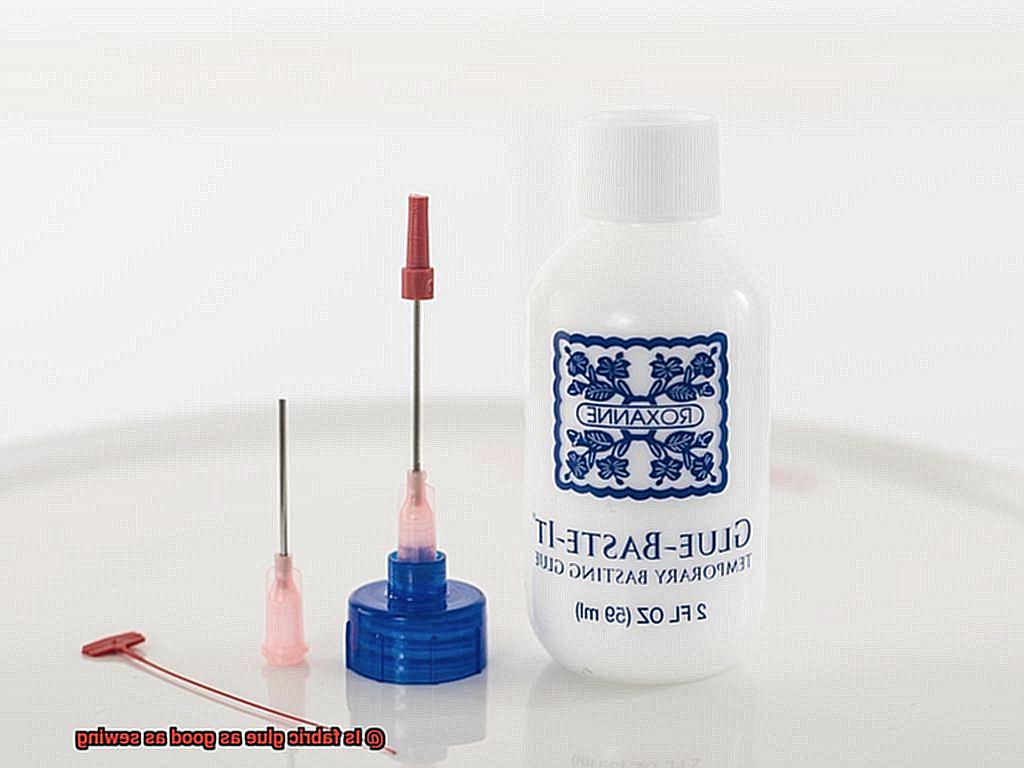
Benefits of Sewing
In a fast-paced world dominated by mass-produced products, sewing offers a refreshing escape. It is a timeless craft that not only allows for self-expression and creativity but also brings numerous benefits to those who wield the needle and thread. From skill development to cost-effectiveness, customization to sustainability, therapeutic benefits to bonding with others, sewing has something for everyone. So grab your fabric and let’s dive into the colorful tapestry of advantages that sewing has to offer.
Creativity and Self-expression:

Sewing is a canvas for your imagination. Choosing fabrics that resonate with your personality and creating unique designs and patterns allows you to express your individuality. Whether stitching a one-of-a-kind dress or adding intricate details to home decor items, sewing offers endless possibilities for creative expression.
Skill Development:
Sewing is more than just a hobby; it’s a valuable skill that can be honed over time. Mastering techniques like stitching, hemming, and buttoning not only improves hand-eye coordination but also enhances attention to detail. Tackling sewing projects develops problem-solving skills and boosts confidence in overcoming challenges.
Cost-effectiveness:
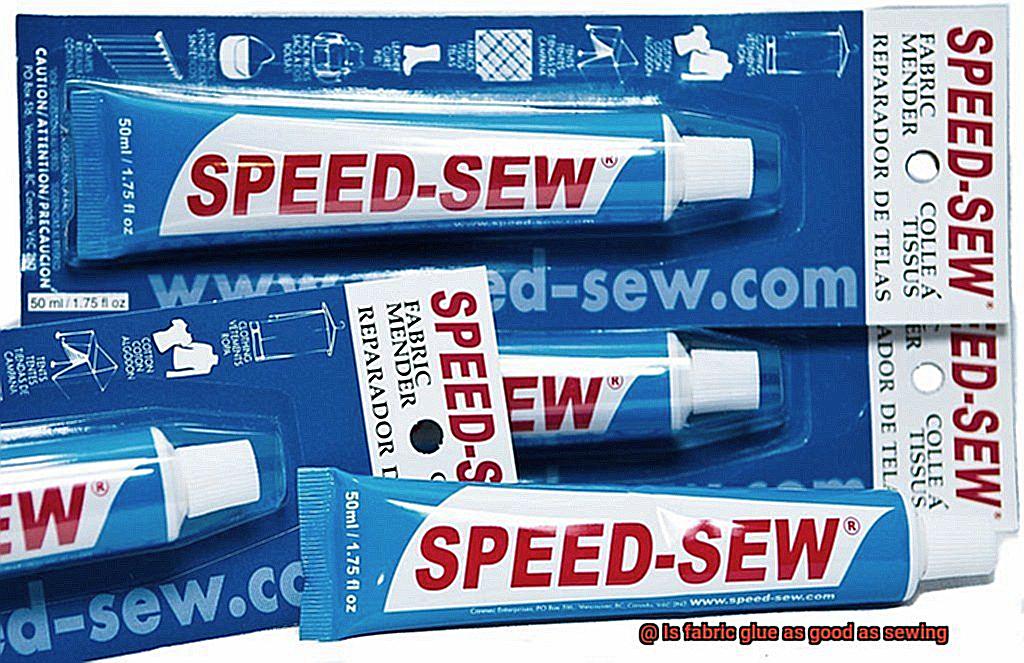
Why break the bank when you can sew? Fabric and sewing supplies are often more affordable than ready-made items, allowing you to create high-quality garments at a fraction of the cost. Moreover, sewing enables you to repurpose old clothes or fabric scraps into new treasures, saving both money and the environment.
Customization:
Say goodbye to ill-fitting clothes. With sewing, you have the power to customize garments according to your measurements and preferences. No more compromising on style or comfort – every stitch is tailored to flatter your unique shape and size. Embrace the joy of wearing clothes that make you feel confident and comfortable in your own skin.
Sustainability:
In a world plagued by waste, sewing offers a sustainable solution. By recycling and upcycling old fabrics and materials, you reduce environmental impact and promote conscious consumption. Embracing the art of mending and altering clothes not only extends their lifespan but also encourages a shift towards a more sustainable fashion industry.
Therapeutic Benefits:
Sewing is not just about the final product; it’s about the journey. The rhythmic motion of stitching has a calming effect on the mind and body, making sewing a therapeutic activity that can reduce stress and anxiety. Engaging in sewing projects provides a sense of accomplishment and allows you to disconnect from the digital world, promoting mindfulness and overall well-being.
Bonding and Socializing:
Sewing is more fun when shared with others. Joining sewing clubs or attending workshops opens doors to meeting like-minded individuals who share your passion for this art form. Collaborative sewing projects and community initiatives create opportunities for bonding, fostering a sense of belonging and creating lasting connections.
Types of Fabrics Suitable for Each Method
When it comes to attaching fabrics, the choice between sewing and fabric glue is not one-size-fits-all. Different fabrics have unique characteristics that make them more suitable for one method over the other. Let’s take a closer look at the types of fabrics that work best with each attachment method and unleash the magic of fabric attachments.
Sewing Sorcery:
Sewing is a magical dance between fabrics and thread, creating sturdy and precise connections. Fabrics like cotton, linen, polyester, and silk are sewing superheroes. With their stable weaves and minimal stretch, they were made to be stitched. They eagerly embrace the needle, allowing for intricate designs and reliable seams. Sewing gives them the chance to shine and showcase their true potential.
Stretchy Challenges:
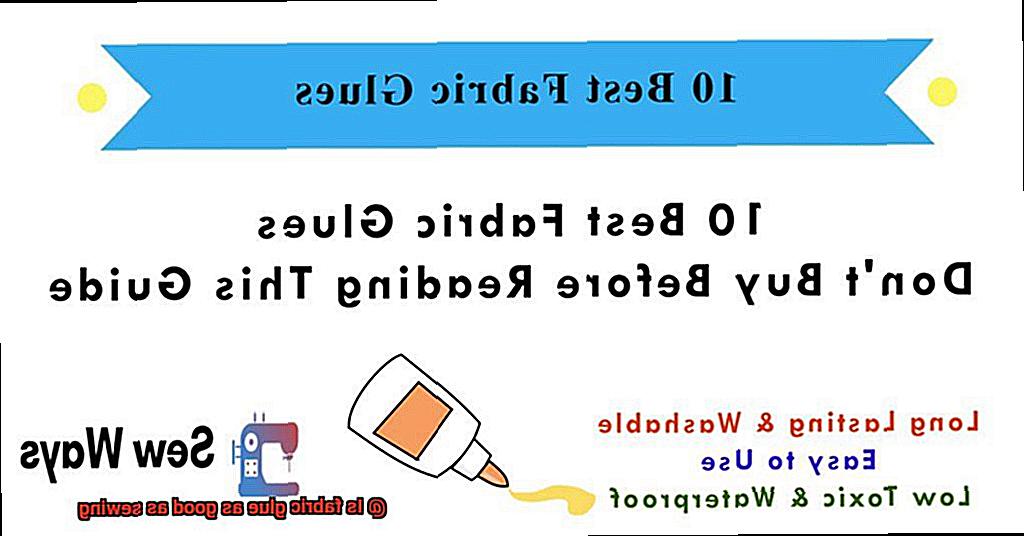
But what about those stretchy fabrics like knits, jerseys, and spandex? They possess an inherent desire to move and stretch, which can be a challenge when it comes to sewing. However, fear not. With a special stretch needle and some zigzag stitches or serging, you can conquer the stretchy fabric kingdom. These techniques accommodate the fabric’s elasticity while ensuring durability and preventing unsightly puckering. Sewing becomes a heroic act of taming the stretchy beasts.
Fabric Glue Magic:
Now let’s explore the realm of fabric glue, a magical elixir that instantly bonds fabrics together. Lightweight fabrics such as cotton, polyester, and blends fall head over heels for fabric glue. The glue effortlessly adheres to their smooth surfaces, creating a strong bond in seconds. It’s like witnessing pure magic. Fabric glue is perfect for quick fixes or temporary alterations, offering convenience and ease of use.
Heavyweight Hurdles:
Beware of heavyweight fabrics like denim, canvas, and upholstery materials. Their heavy textures demand the strength of sewing to hold them together. While fabric glue may provide a temporary bond, it won’t withstand their weight for long. These fabrics crave the security and resilience that sewing offers, ensuring their longevity and durability. Sewing becomes a heroic act of defying gravity and keeping heavyweight fabrics intact.
Fuzzy Friends:
Last but not least, let’s not forget about the fuzzy fabrics like velvet or corduroy. Their unique texture can make fabric glue struggle to bond effectively, leading to a lackluster connection. However, sewing swoops in as the superhero in this scenario. With its unrivaled control and precision, it conquers the fuzziness and creates seamless bonds. Sewing becomes an art form, delicately navigating the fibers and ensuring a flawless union.
Durability and Permanence of the Bond
Whether you’re a seasoned seamstress or a crafting enthusiast, the question of durability and permanence always comes into play. Should you rely on the trusty needle and thread, or does fabric glue have what it takes to hold its own? Let’s dive into the differences between these two techniques and uncover which one reigns supreme.
The Sewing Superpower:
When it comes to durability, sewing is the undisputed champion. With interlaced stitches securely holding fabrics together, your creations are built to withstand the test of time. This method shines brightest for garments and items that will frequently face washing and heavy use. From sturdy denim jeans to intricate quilts, sewing ensures a bond that won’t unravel at the seams.
Fabric Glue’s Instant Magic:
Fabric glue, on the other hand, offers convenience and speed. It’s perfect for lightweight fabrics and delicate embellishments like beads or sequins. With a simple application, fabric glue creates an instant bond that eliminates the need for time-consuming stitching. It’s like having a fairy godmother granting your wishes for quick fixes and decorative touches.
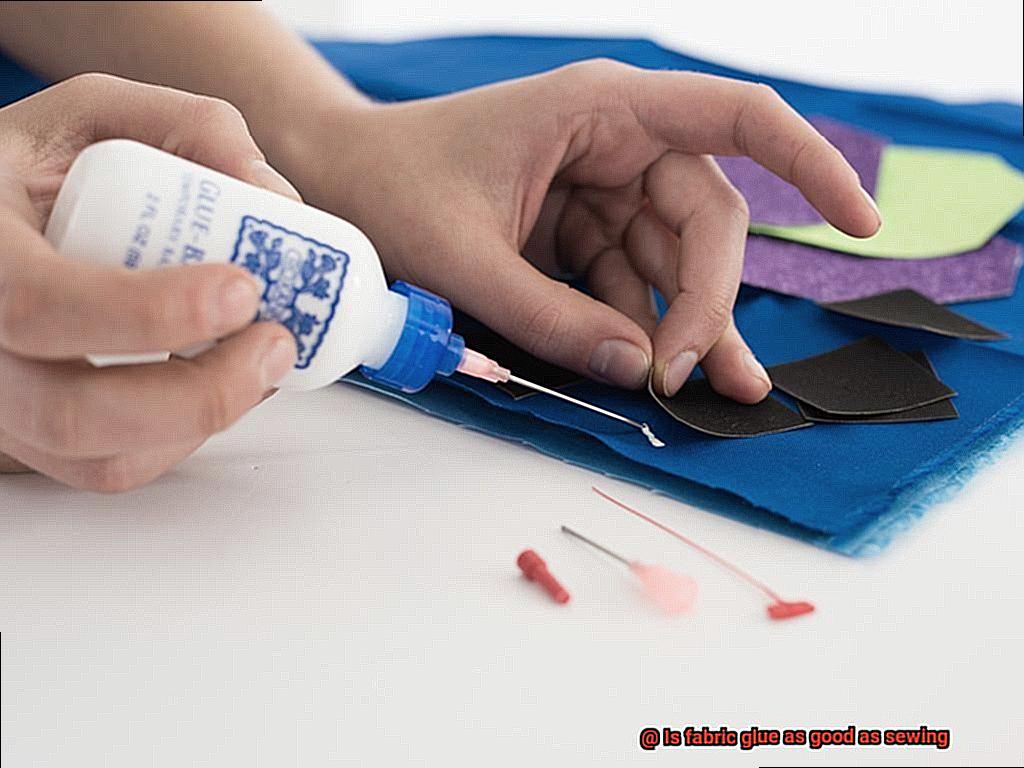
Advancements in Fabric Glue:
Don’t underestimate the power of fabric glue. In recent years, manufacturers have developed formulas specifically designed for fabric bonding. These super glues claim to be machine washable and durable, making them a viable alternative to sewing. However, it’s crucial to choose the right product for your fabric type and follow manufacturer instructions carefully.
Considerations for Fabric Choice:
While fabric glue may seem like the superhero sidekick you’ve been waiting for, some materials don’t fare as well with this method. Fabrics with loose weaves or delicate fibers may not adhere as securely, leading to potential issues down the line. Additionally, heat or exposure to certain conditions can weaken fabric glue’s bond. Be mindful of extreme temperatures or humidity and take extra precautions to ensure the longevity of your project.
Tips for Success:
- Read product labels carefully and choose a fabric glue suitable for your specific fabric type.
- Reinforce fabric glue bonds with additional sewing for added durability, especially on heavyweight or fuzzy materials.
- Follow manufacturer instructions regarding care and maintenance to maximize the longevity of the bond.
- Test fabric glue on a scrap piece of fabric before applying it to your project to ensure compatibility and desired results.
Visible Residue or Stiffness in the Fabric
Fabric glue vs. sewing: the eternal debate in the world of crafting and garment-making. Both methods have their own merits, but when it comes to visible residue or stiffness in the fabric, there are some key differences to consider.
Let’s start with fabric glue. It’s undoubtedly a convenient option, especially for those who may not have sewing skills or access to a sewing machine. Fabric glue allows you to easily bond fabric pieces together, creating a strong and durable hold.
However, one downside is that certain fabric glues can leave behind a visible residue. This can be particularly noticeable on lighter fabrics or those with a delicate finish. Imagine spending hours creating a beautiful garment, only to have it marred by an unsightly residue.
On the other hand, sewing doesn’t leave any visible residue on the fabric. By using thread to join fabric pieces together, you maintain the integrity of the fabric’s appearance.
There’s no need to worry about any shiny or discolored marks detracting from your hard work. Additionally, sewing allows for more flexibility in the fabric as it doesn’t alter its natural characteristics. This is especially important for garments or projects that require movement or drape.
But let’s not dismiss fabric glue just yet. While some glues may leave visible residue or stiffness, not all do. There are high-quality fabric glues available that are specifically formulated to minimize these issues. These glues dry clear and remain flexible, ensuring that the fabric retains its original texture and appearance. So if you’re set on using fabric glue, be sure to choose a trusted brand and carefully read the instructions to avoid any unwanted effects.
In conclusion, while fabric glue offers convenience and ease of use, it may result in visible residue or stiffness in the fabric. Sewing, on the other hand, does not leave behind any visible marks or alter the flexibility of the fabric. It’s important to consider these factors when deciding between fabric glue and sewing for your projects, and to choose the method that best suits your needs and preferences.
Cost Comparison
When it comes to crafting or repairing fabric items, two popular methods stand out: fabric glue and sewing. Both have their advantages and disadvantages, with cost being a significant factor. In this post, we will delve into the costs associated with fabric glue and sewing for different projects. Whether you’re a DIY enthusiast or simply looking for the most cost-effective option, read on to discover which method best suits your needs.
Initial Investment:
Fabric glue takes the lead in terms of initial investment. It is readily available at affordable prices in most craft stores, while sewing necessitates purchasing a sewing machine, needles, thread, and other accessories, which can be quite expensive.
Long-term Costs:
Although fabric glue may be cheaper initially, sewing proves to be more economical in the long run. Sewn garments tend to be more durable and have a longer lifespan compared to those assembled with fabric glue. This translates to fewer repairs or replacements over time, ultimately saving you money.
Material Compatibility:
While fabric glue can be used on a variety of fabrics, delicate materials such as silk or chiffon might not adhere well to it. On the contrary, sewing allows for greater flexibility and compatibility with different fabrics. Additionally, certain projects may require specific stitching techniques or embellishments that cannot be achieved with fabric glue alone.
Time and Effort:
Fabric glue emerges as the quicker and more convenient option compared to sewing. Applying glue requires minimal skill or experience, making it ideal for quick repairs or simple projects. However, sewing demands more time and precision, especially when dealing with complex designs or garment construction.
Strength of the Bond:
Although fabric glue can create a strong bond between fabrics, it may not withstand repeated washing or heavy use as well as sewn seams do. Sewing provides stronger and more durable results, ensuring that your creations withstand everyday wear and tear.
Personal Preference:
Ultimately, personal preference plays a significant role in choosing between fabric glue and sewing. Some individuals find sewing more enjoyable and rewarding, making the additional costs worth it. Others prefer the simplicity and convenience of fabric glue, especially if they have limited sewing skills or are working on straightforward projects.
When comparing the cost of fabric glue versus sewing, various factors come into play. These include initial investment, long-term durability, material compatibility, time and effort required, strength of the bond, and personal preference. Both methods have their advantages and disadvantages, so it’s crucial to carefully consider these factors before deciding which method suits your project or repair needs.
Creative Options
Prepare to embark on a journey into a world of boundless artistic options that can elevate your crafting projects to new heights. In this post, we will delve into the advantages and possibilities that fabric glue brings to the table, revolutionizing the way you approach your creative endeavors.
Versatility:
Fabric glue emerges as an unrivaled champion in terms of versatility. Unlike traditional sewing techniques, which demand different approaches for various fabrics, fabric glue transcends these limitations. It gracefully adheres to an array of materials, including cotton, denim, silk, and even leather. With fabric glue, you can explore different fabric types without the need for specialized equipment or extensive knowledge of multiple sewing methods.
Strong Bond:
Fabric glue is not merely a quick fix; it empowers you with an unwavering bond that securely holds fabrics together. Bid farewell to concerns about loose stitches or seams coming undone. Whether you’re hemming pants, repairing seams, or attaching embellishments to garments, rest assured that fabric glue will fortify your creations against the trials and tribulations of regular wear and tear.
Intricate Designs and Patterns:
Prepare to unlock a realm of boundless artistic expression with fabric glue as your steadfast companion. While traditional sewing techniques confine you to a limited range of stitches, fabric glue grants you the freedom to effortlessly affix appliques, lace, rhinestones, and other decorative elements to your fabric. Allow your imagination to wander as you craft unique and personalized touches that breathe life into your creations.
Precision and Control:
When working with delicate or minute items, sewing can prove challenging and precarious. Enter fabric glue, the solution that eradicates the need for stitching in these delicate situations. Bid adieu to worries about inadvertently damaging fragile materials. With fabric glue, precision and control are yours to command, empowering you to focus on intricate details without fear.
Convenience and Time Efficiency:
Gone are the days of laborious setup and time-consuming thread threading. Fabric glue offers unparalleled convenience and time efficiency. Simply grab a bottle or tube and apply the glue directly to your fabric, minimizing preparation and clean-up. Embrace the expedience that fabric glue affords, whether you seek quick fixes, last-minute alterations, or simply yearn to save precious time on your projects.
mORL1jJSdlk” >
Conclusion
Fabric glue may seem like a convenient alternative to sewing, but in reality, it falls short when it comes to durability and longevity.
While fabric glue can be useful for quick fixes or temporary projects, it cannot withstand the test of time like sewing can. Sewing provides a stronger bond that is less likely to come undone or fray over time.
So, if you’re looking for a reliable and long-lasting solution, sewing is definitely the way to go.

